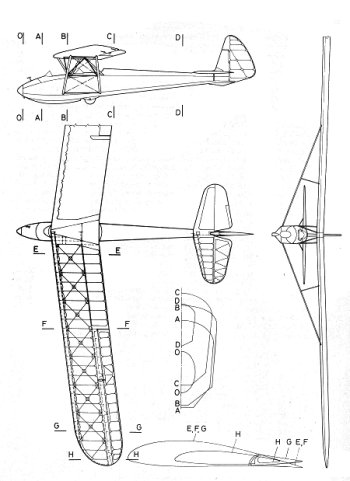HUNGARIAN
GLIDERS
1933-2000
| Type designation: |
R-11b |
| Name: |
Cimbora |
| Designer: |
Ernő RUBIK |
| Class: |
Two-seater trainer |
| General arrangement: |
Strutted high-wing, tandem seats, traditional tail unit |
| Crew: |
2 |
| First flight: |
May 9, 1940 |
| Manufacturer: |
Aero Ever Kft. |
| Number of built: |
Cca. 62 |
.jpg)
Short history:
In 1939 the president of the Aeroclub of the Thechnical University, László Tasnádi, formulated the requirement for a two-seater glider which would be suitable to train students, having already earned their B badges, in aerotow. The Hungarian Aeronautical Society ordered a tandem two seater, strutted high wing, basic training glider with aerotow launching capability from Aero Ever Kft. The specifications was drawn up by Lajos Rotter.
The prototype of the R-11 glider first flew in May 1940. Originally it was called Gólya (Stork). The evaluation of the test flights and the requirements of newly published airworthiness regulations resulted in a couple of modifications. The new versions got the type designations of R-11a, R-11b and R-11b1 respectively, however the modifications applied on the different variations are not exactly known. The version, which was built in series from 1941, had got the designation of R-11b and the name of Cimbora (Buddy). Some 50 were built by Aero Ever in Esztergom, and 12 by the Aircraft Factory of Transylvania in Nagyvárad (Oradea).
The type were used for aerotow training as well as for familiarization flights on ridge-flying up to 1950. At Jun 6, 1942 Sándor Retkes and János Stolte had accomplished a duration flight of 20 h 44 m with Cimbora, which was topped, also with a Cimbora, by Géza Vass and Endre Lacza in August 1948 by a duration of 25 h 07 m.
.jpg)
Structure: All wooden
Wing:
The double-spar wings of the high-wing glider were braced by double struts, and were swept by 7,5 degres. Because of the double struts and the diagonal stiffeners between the two spars no torsional box was formed on the wings. The wings were mounted on N-form steel-tube frames above the fuselage. The streamlined steel-tube double struts were braced by diagonal wires and at half-length they were connected to the main spars by lighter steel-tubes. The ailerons were slotted. No flaps or airbrakes were fitted.
Fuselage:
The Cimbora's fuselage were contructed of wooden frames connected by longerons and covered by plywood. The sides and the bottom had flat, the top had an arched form. The seat of the student was placed in front of the N-form wing-supporting frames. It had an open, movable canopy with a simple windshield. The seat of the instructor was under the aft part of the wing. A horizontally hinged door opening upward facilitated getting in- and out of the aft seat. A simple windshield was placed on the fuselage in front of the instructor's seat. The landing gear consisted of a long skid which run from the nose to the fixed wheel placed in front of the C.G. A small aft skid completed the landing gear.
Tail unit:
The tail unit was arranged tarditionally. The horizontal stabilizer was braced by struts.
.jpg)

.jpg)
.jpg)
.jpg)
